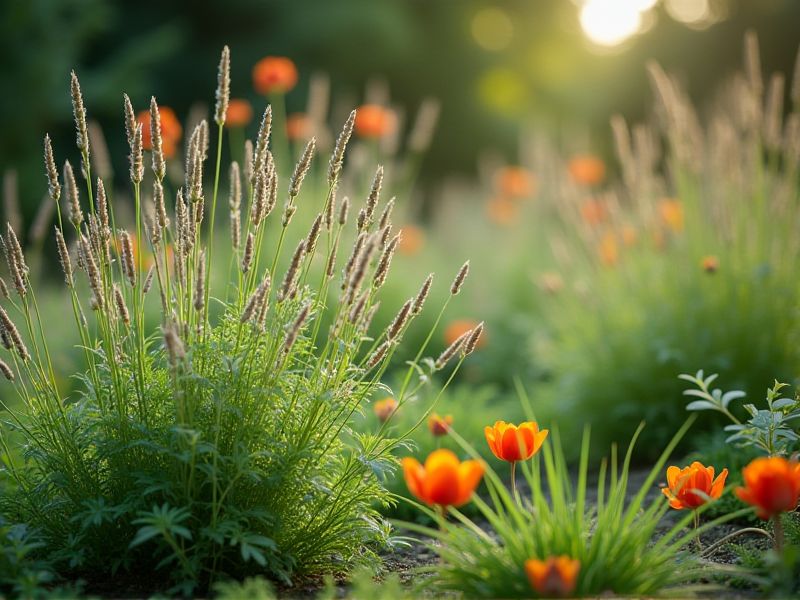
Native plants, adapted to local climates, require minimal to no additional watering once established. Species such as lavender, succulents, and local grasses thrive naturally in their environments, providing resilience against drought. These plants not only conserve water but also support local ecosystems, attracting pollinators like bees and butterflies. Incorporating native flora into your garden reduces the need for synthetic fertilizers and pesticides, promoting biodiversity. By choosing these drought-resistant species, you can create a sustainable landscape that flourishes with minimal maintenance.
List of some Native plants that need no watering
- California Poppy (Eschscholzia californica)
- Blue Oak (Quercus douglasii)
- Joshua Tree (Yucca brevifolia)
- Lavender (Lavandula spp.)
- Succulent Plant (Various species)
- Eastern Redcedar (Juniperus virginiana)
- Sagebrush (Artemisia tridentata)
- Yarrow (Achillea millefolium)
- Desert Marigold (Baileya multiradiata)
- Prickly Pear Cactus (Opuntia spp.)
Important things about Native plants that need no watering
Drought Tolerance
Native plants adapted to arid conditions offer excellent solutions for achieving drought tolerance in your garden. Species such as lavender, sage, and yucca thrive in low water environments, making them ideal choices for sustainable landscaping. These plants not only require minimal to no additional watering once established, but they also provide essential habitats for local wildlife, promoting biodiversity. By selecting native plants, you contribute to water conservation efforts while enhancing the aesthetic appeal of your outdoor space.
Soil Adaptation
Native plants are uniquely adapted to their local ecosystems and typically require little to no supplemental watering once established, making them ideal for sustainable gardening. Species such as California poppy and black-eyed Susan have evolved to thrive in their native environments, developing deep root systems that efficiently access soil moisture. By incorporating these drought-resistant plants into your landscape, you can create a beautiful garden that supports local wildlife while conserving water resources. Embracing native flora not only enhances biodiversity but also promotes healthier soil through natural processes, reducing the need for chemical fertilizers.
Wildlife Support
Native plants, such as lavender, sage, and yucca, thrive in local ecosystems without the need for supplemental watering once established. These drought-tolerant species are adapted to the local climate, contributing to biodiversity and providing habitat for wildlife. By incorporating native plants into your garden, you not only reduce water usage but also attract pollinators like bees and butterflies, enhancing ecological balance. Choosing these resilient species promotes sustainability and supports the health of the environment in your area.
Low Maintenance
Native plants like succulents, desert marigolds, and yuccas thrive in arid conditions, requiring minimal to no supplemental watering once established. These drought-resistant species are perfectly adapted to local climates, enhancing biodiversity while promoting soil health. Incorporating such plants into your garden not only conserves water but also supports local wildlife by providing essential habitat. By choosing native flora, you can create a sustainable landscape that requires less maintenance and offers enduring beauty year-round.
Climate Resilience
Native plants are essential to fostering climate resilience, particularly in drought-prone areas where water conservation is critical. These species, which have adapted to local environmental conditions over generations, require little to no watering once established, helping to reduce water usage significantly. By incorporating native plants such as purple coneflower, black-eyed Susan, and desert marigold into your landscaping, you can support local ecosystems while minimizing maintenance costs. Embracing these hardy plants not only enhances biodiversity but also contributes to healthier soil and improved air quality in your community.
Nutrient Requirements
Native plants, such as succulents and drought-resistant shrubs, have evolved to thrive in specific environments with minimal water. These plants typically require fewer nutrients compared to non-native species, as they have adapted to nutrient-poor soils. By utilizing deep root systems, they draw moisture and essential minerals from the ground, enabling them to flourish in arid conditions. Planting these native species not only conserves water but also supports local ecosystems and wildlife.
Local Biodiversity
Native plants that require no watering play a crucial role in promoting local biodiversity and enhancing your garden's resilience. Species such as California poppy and black-eyed Susan thrive in their natural environments and are well-adapted to local climatic conditions. By incorporating these drought-tolerant plants, you not only conserve water but also provide habitat for essential pollinators like bees and butterflies. Creating a landscape with native flora can significantly reduce maintenance while supporting the ecosystem you cherish.
Pest Resistance
Native plants, such as California poppy and purple coneflower, demonstrate remarkable pest resistance while requiring minimal watering, making them ideal for sustainable gardening. These plants have evolved alongside local ecosystems, developing natural defenses against common pests like aphids and caterpillars. By integrating native flora into your landscape, you significantly reduce the need for chemical pesticides and fertilizers, promoting environmental health. Embracing drought-tolerant native species not only conserves water but also supports local biodiversity.
Seasonal Interest
Native plants are a sustainable option for gardens, requiring little to no watering once established, making them an ideal choice for xeriscaping. Species such as the California poppy, agave, and purple coneflower thrive in their native habitats, showcasing resilience against drought conditions. You'll discover that these plants support local wildlife, including pollinators like bees and butterflies, enhancing biodiversity in your outdoor space. Embracing native landscaping not only conserves water but also promotes the ecological balance of your region.
Ecological Benefits
Native plants provide significant ecological benefits by supporting local wildlife and reducing water usage. These drought-resistant species, adapted to your region's climate, thrive without additional irrigation, conserving precious water resources. By planting native varieties, you create habitats for pollinators like bees and butterflies, ensuring ecosystem balance. Moreover, native plants improve soil health and reduce erosion, contributing to overall environmental sustainability.
